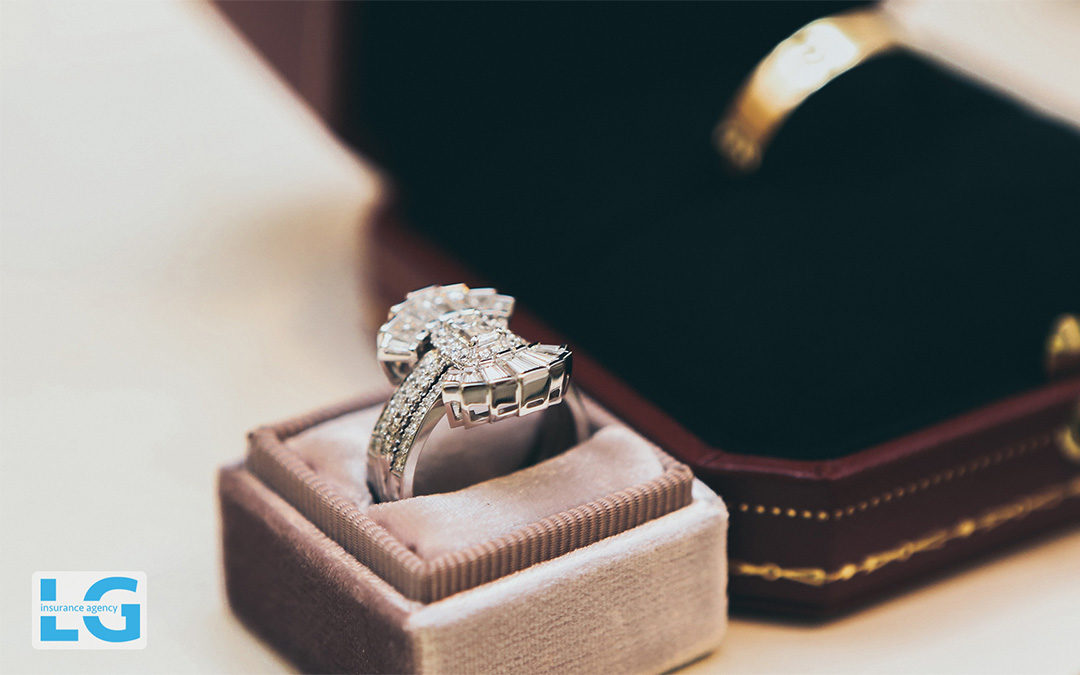Jewelry insurance, particularly for important, valuable, or sentimental pieces, is a smart way to protect not only your investment, but something that holds emotional value to the owner as well. So how does insurance for your jewelry work? What does jewelry insurance look like, how do you obtain it, and how can you be sure you’re protecting your assets while getting the most value for your money? Let’s discuss jewelry insurance as a whole, before we go over some of the finer points and frequently asked questions.
A common consideration, and oftentimes the first time consumers may start looking into jewelry insurance is after purchasing or receiving an engagement ring. Prior to that kind of emotional-value and financial high-ticket item clients may not have had something that triggered an interest in jewelry insurance. There are a variety of ways that you can choose to insure your jewelry, but the most common are to either purchase a stand-alone policy from an insurance company that offers jewelry policies, or add jewelry coverage to a homeowner’s or rental insurance policy with a scheduled floater.
What does that mean? A scheduled floater for an expensive piece of personal property allows your policy to endorse coverage of high-value items that are likely targets during a theft or other type of covered loss.
When seeking out a policy, either stand-alone or added into an existing policy like homeowner’s or renter’s, there’s some preparations that will need to be done. Your insurance professional can walk you through the process in detail, but they’ll be looking for specific types of information to help you determine the value of the piece or pieces you’re looking to insure. For example, if it’s a new piece of jewelry, you’ll want to have the receipt from purchase, color photos of the item or items, and if an appraisal has been done, a copy of the appraisal forms. If, rather than a new piece, it’s an heirloom or estate jewelry item, an appraisal is always recommended. For any items, you’ll want to have insurance policies that cover the appraised value.
Depending on the insurance company you choose to purchase your policy from, loss settlement may be the appraised value of the item, or it could be replacement of the item. Some jewelry companies’ insurers will contract their own jeweler to remake your item. Be sure to pay close attention to the details of your policy- if you’ve insured a piece of Tiffany or Cartier branded jewelry, and your policy covers replacement, you may end up with a replica piece that has been remade as a replacement for your loss. While the item may look the same, it won’t be that same branded piece of jewelry. While some policies may contact those branded shops for repairs or replacements, others will go the more utilitarian route, so it’s important to look carefully at the details of your policy before you purchase. Much like a homeowner’s policy, functional coverage isn’t always going to cover the specifics of what you’re looking to repair or replace- including high-end or estate jewelry pieces. In those cases, stand-alone policies are your friend.
Stand-alone coverage, or companies that specialize in jewelry coverage will obviously include more options than an add-on. You may choose to include “mysterious disappearance” coverage, which will cover pieces that may have been stolen, or could have been misplaced instead. Stand-alone policies also often include jewelry repair services- so if you need to have a setting repaired, clasp remade, etc. a stand-alone policy likely has more options for you. If you’re especially particular about your jewelry pieces, as you’re likely to be if you’re seeking out insurance for them, there are some questions you should keep in mind as you’re discussing policies with your insurance professional. If you’re insured for replacement rather than cash payout, are there limited options as to where you can purchase your replacement piece? What is the policy if a suitable or comparable replacement cannot be found? Are you able to choose who will do jewelry repairs, or does the insurance company have preferred vendors/ technicians? Are damages covered as well as loss and theft? These are details that, depending on your needs, you should seek out the information prior to making your choice.
A commonly asked question is whether or not jewelry insurance is tax-deductible. The simplest answer is- not really. While you’d be better served asking this kind of question to your accountant or tax-specialist, generally speaking- insurance payments, unless they are for a business, are not tax-deductible. A quick Google search will reveal that the IRS doesn’t typically allow for the claim of losses that relate to personal property that your own- and jewelry falls under that particular category. For a more detailed explanation we definitely recommend reaching out to a tax or accounting professional. Let’s address another frequently asked question: Does making a claim on your jewelry rider (or add-on) affect the overall policy when it’s bundled with your homeowners/ renters policy? The short answer for this one? Yes. Like making a claim on any kind of policy, if your jewelry is lost or stolen and you need to file a claim, it can affect your entire policy’s premium, as well as your eligibility for your policy, which is important to keep in mind when choosing how to insure your jewelry.
All in all, jewelry is more than just a beautiful and valuable adornment- it’s often part of a family legacy, or a significant investment that symbolizes an important moment in one’s life. With that in mind, if you think you’d be upset if you lost or something happened to a piece of jewelry you own, you likely should get it insured. Insuring your jewelry can be as simple as adding a rider to an existing policy or getting a stand-alone policy that comes with a full suite of services including repair and replacement. For more information, chat with one of our professionals anytime.


